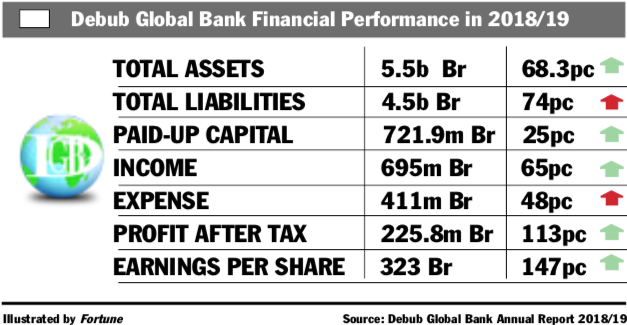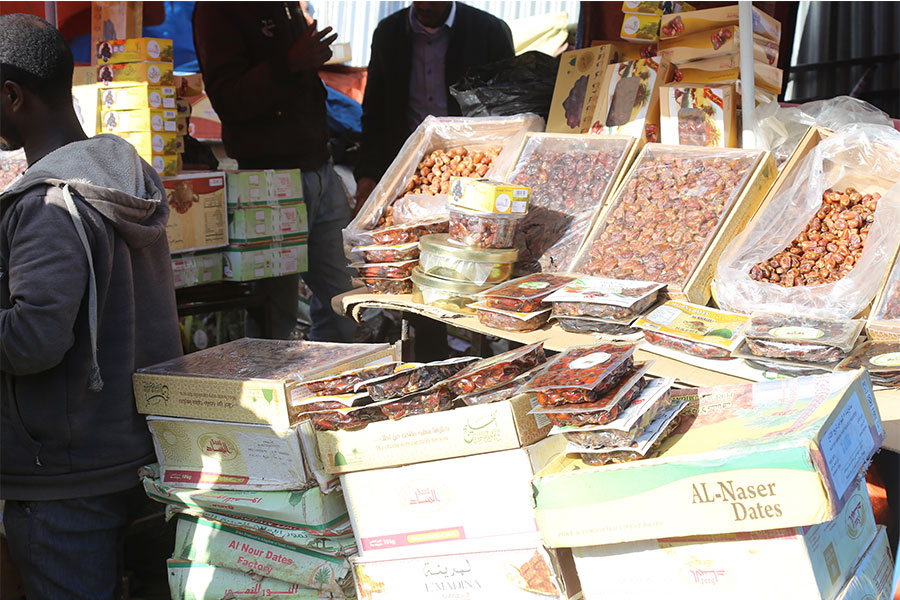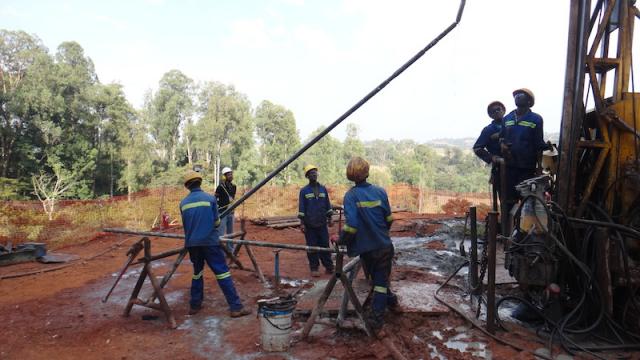
Fortune News | Jan 25,2020
The Bank of Abyssinia’s (BoA) financial results for the fiscal year 2023/24 tell a story of growth mixed with rising costs and narrowing returns. However, a particularly notable development came from its foreign exchange activities.
Net foreign exchange income turned positive at 99.19 million Br, compared with a loss of 223.56 million Br the previous year. Based in London, financial statement analyst Abdulmenan Mohammed (PhD) called the turnaround “remarkable,” a bright spot in an otherwise cautious market.
Yet, beneath the positive development in the forex front, Abdulmenan noted what should be a concerning trend. Earnings per share (EPS) have declined for two consecutive years, at 33pc last year, dropping by five percentage points from the previous year, still at par with the industry average.
Provision for loan and asset impairments rose by 7.3pc to 1.03 billion Br, a substantial sum that signals the Bank’s need to scrutinise credit management. The current 0.66pc level of provisions aligns roughly with the industry’s long-term average of around 0.5pc, a sign that BoA’s risk management stood on relatively stable ground. Still, observers say the environment could shift quickly, and prudent provisioning today may not fully insulate the Bank in the future.
According to Abraham Gebeyehu, Abyssinia Bank's chief retail banking officer, the Bank is moving to diversify its revenue streams and manage costs through more judicious resource use. The approach prioritises high-yielding product portfolios that can offset rising expenses and regulatory restrictions.
Total assets expanded by 17.3pc to 222.3 billion Br, which places the Bank squarely within an industry-wide pattern of private lenders enjoying double-digit asset growth. Management and analysts say this expansion is no small feat in a market defined by uncertainty and tightening regulatory curbs. However, the Bank’s profit profile is beginning to show signs of stress beneath the surface.
Net profit after tax rose by 9.3pc to 4.24 billion Br, less than that of a peer like Dashen Bank, at 4.88 billion Br. Though the profit gain is not insignificant in an environment shaped by inflation and foreign exchange crunch, it signals a broader truth about Abyssinia Bank and its first-generation peers. Size and expansion alone do not guarantee a firm foothold in the evolving financial sector.
As industry averages once neared a 2.6pc return on assets, BoA’s 1.91pc figure showed the erosion of profitability at a time when growth strategies no longer translate seamlessly into robust returns. Bekalu Zeleke, president of Abyssinia Bank, attributed this trend to the Bank's "exceptional growth in assets" over the past five years.
"One of our biggest challenges is that capital growth is not matching assets expansion," he told Fortune.
Analysts see as a sign that BoA is good at in using its capital to optimise efficiency, but the President acknowledged the inherent risk during times of volatility.
Executives in the private banking sector have grown accustomed to years of steady asset build-ups and surging profits. Over the decade beginning in 2013, the private banking industry enjoyed healthy expansion and a manageable set of non-performing loans (NPL), even amid periodic regulatory changes. Abyssinia Bank’s current performance demonstrates that it is a mature institution that has capitalised on this long growth trajectory but now stands at a critical turning point.
Bekalu and his senior executives have built a formidable resource base, yet the escalating cost of operations and narrowing profit margins reveal the fragility of that achievement. They appear to have learned that more moderate margins are the price of doing business in a market faced with cost pressures and structural inefficiencies.
A closer look at BoA’s expense structure shows wage, benefits, and administrative costs prominently placed. These costs represent over half of total expenses, a reminder that operations remain resource-intensive. The wider private banking market’s wage and administrative expenses are usually around five percent of assets.
According to the analyst, BoA’s executives could do more to squeeze efficiencies out of its structure, whether by rethinking resource allocations, tightening controls, or embracing technology to curb costs.
Where BoA sets itself apart is the intensity of its core lending operations.
Revenue gains have come from both financial and nonfinancial intermediation. Income climbed by 22pc to 27.7 billion Br, a jump stemmed mainly from a 17.4pc rise in interest on loans, advances, and central bank bills, which reached 24.6 billion Br. Service charges and commissions soared by nearly 48pc to 2.1 billion Br, while other income shot up almost 67pc to 946.8 million Br.
Its loan-to-asset ratio was 75.46pc, and its loan-to-deposit ratio was 87.13pc, both strong indicators of aggressive lending. In more placid times, such assertiveness could enhance margins. But when liquidity buffers and foreign currency availability are as precarious as they are now, pushing the lending envelope can increase vulnerability.
BoA’s capital-to-asset ratio (6.39pc) was well below the 10-year private bank average of 13.5pc. With an asset-to-equity ratio of 9.59, the Bank appears to have a leaner capital structure that could amplify sensitivity to sudden shifts in the business environment.
Net interest income accounted for roughly 59.74pc of total income, somewhat below the historical industry norm of around 65pc to 73pc. This shortfall may show strategic diversification. According to the analyst, should interest margins tighten further, a well-balanced income stream could serve as a cushion.
According to Bekalu, Abyssinia Bank will focus on beefing up forex earnings in the coming years. This is one strategy to diversify revenue streams, along with customer acquisitions.
Abyssinia Bank’s expansion strategy has been aggressive, as demonstrated by the opening of 67 new branches, bringing the total to 930. The broadened footprint contributed to deposit growth of more than 21pc, with an average deposit per branch reaching 207 million Br. These speak to a strong franchise and the potential to reap efficiencies if adequately managed.
The workforce shrank slightly to 11,455 employees from 11,508 the previous year, but wages and benefits rose by over 22pc to 9.11 billion Br. General administrative expenses grew by nearly 46pc to 4.31 billion Br, driven partly by deposit insurance payments of 472.3 million Br.
While these figures represent rising overhead, they have not undermined productivity. Profit per employee was over 370,000 Br, far above a decade-long private banking average of 76,000 Br, signalling well-utilised human capital.
Fikremariam Terefe manages one of the branches in the Meskel Flower neighborhood. He characterised the fiscal year as “triumphant for resource mobilisation and accessibility.” He plans to carry out the Bank's five-year strategy, which anchors on digital transformation, a broader forex offering, and expanded credit services for high-value clients.
“We plan to improve efficiency and leverage digital technology to optimise operations,” he told Fortune. “Our virtual banking centre has operated round-the-clock.”
For Board Chairperson Mekonnen Manyazewal, BoA’s human remains the foundation of the Bank’s strategy.
"We believe it's the most important resource of the Bank," he said.
Mekonnen, once a senior minister under the EPRDF-led government, acknowledged that recent regulatory changes - covering lending exposure limits, asset classification, provisioning standards, and corporate governance — have influenced performance. The Bank’s approach appears to reflect a willingness to adapt, though adaptation often brings costs before yielding returns.
Total assets marched upward by 17.3pc to 222.3 billion Br. Loans and advances reached 163.92 billion Br, a 14.4pc increase, almost consistent with a credit ceiling imposed by the National Bank of Ethiopia (NBE) in August 2023. Deposits climbed 21.4pc to 192.51 billion Br, lowering the loan-to-deposit ratio from 90.7pc, in line with the regulator’s constraints.
While abundant resources might have once fueled more lending, the new credit cap requires selective allocation. Abraham disclosed that Abyssinia Bank has focused on high-yielding products with a multiplier effect on revenue to respond to the impact of the credit limit.
Liquidity levels rose in both absolute and relative terms. Cash and bank balances jumped more than 32pc to 27.94 billion Br, raising the ratio of cash and bank balances to total assets from 11.16pc to 12.6pc. The analyst, Abdulmenan, called this progress “noteworthy but not entirely comforting,” warning that liquidity remains a concern, and that BoA’s executives should keep a vigilant eye on developments.
Annual expenses grew to 22.4 billion Br, with interest on savings alone up by over 30pc to 8.02 billion Br. Observers attributed this increase to a combination of higher deposits and rising average savings rates, perhaps influenced by economic conditions and mounting competition.
According to Abraham, inflation and the rising cost of living pushed up expenses, and the Bank plans to leverage digital technology to curb them. Virtual banking has been another investment area, with 35 centres in operation, 15 of which opened during the reporting year.
Bekalu reinforced this view, disclosing that no branch will be opened this year as part of the review of branch models, while the Bank will invest resources in digitisation. According to him, his management's focus will be on cost reduction and enhancing employee productivity.
Abyssinia Bank’s capital adequacy ratio of 11.4pc sits above the regulatory minimum, providing some comfort. Still, analysts urge the Bank to beef up its capital as a precaution. According to Abraham, BoA has raised capital by more than 15pc each year, a trend he sees is likely to continue. Abyssinia Bank’s paid-up capital rose by 19.4pc to 14.21 billion Br.
Shareholders express a mix of understanding and frustration.
Some are less satisfied. Tesfaye Berhanu, who attended the annual general assembly held in November 2024, in Inter Luxury Hotel, on Marshal Tito Road, had hoped for bigger dividends. He blamed rising expenses, which he believes dampened earnings per share. His sentiment echoed those who feel that, while growth looks good on paper, the bottom line would be stronger if expenses were reined in more aggressively.
Workneh Gashaw, who has held shares for about five years, supported the idea of retaining earnings to build capital and cover provisions. He believes remaining competitive in a shifting market justifies a tighter dividend policy.
PUBLISHED ON
Dec 08,2024 [ VOL
25 , NO
1284]

Fortune News | Jan 25,2020

Featured | Jan 07,2024

Featured | May 25,2019

Radar | Jul 17,2022

Fortune News | Feb 29,2020

Fortune News | Feb 23,2019

Fortune News | Nov 18,2023

Viewpoints | Mar 13,2021

Radar | Aug 06,2022

Fortune News | Apr 03,2023

Dec 22 , 2024 . By TIZITA SHEWAFERAW
Charged with transforming colossal state-owned enterprises into modern and competitiv...

Aug 18 , 2024 . By AKSAH ITALO
Although predictable Yonas Zerihun's job in the ride-hailing service is not immune to...

Jul 28 , 2024 . By TIZITA SHEWAFERAW
Unhabitual, perhaps too many, Samuel Gebreyohannes, 38, used to occasionally enjoy a couple of beers at breakfast. However, he recently swit...

Jul 13 , 2024 . By AKSAH ITALO
Investors who rely on tractors, trucks, and field vehicles for commuting, transporting commodities, and f...

Oct 25 , 2025
The regulatory machinery is on overdrive. In only two years, no fewer than 35 new pro...

Oct 18 , 2025
The political establishment, notably the ruling party and its top brass, has become p...

Oct 11 , 2025
Ladislas Farago, a roving Associated Press (AP) correspondent, arrived in Ethiopia in...

Oct 4 , 2025
Eyob Tekalegn (PhD) had been in the Governor's chair for only weeks when, on Septembe...